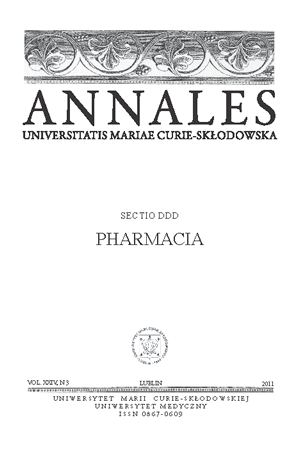Charakterystyka właściwości przeciwdrgawkowych różnych pochodnych p-izoporopoksyfenylo-bursztynimidów w teście maksymalnego wstrząsu elektrycznego u myszy
DOI:
https://doi.org/10.12923/Słowa kluczowe:
padaczka, pochodne -izoporopoksyfenylobursztynimidów, test drgawek indukowanych maksymalnym wstrząsem elektrycznym.Abstrakt
Celem przeprowadzonych badań było określenie, czy niektóre pochodne p-izoporopoksyfenylobursztynimidów wykazują właściwości przeciwdrgawkowe w teście maksymalnego wstrząsu elektrycznego myszy. Piętnaście pochodnych p-izoporopoksyfenylobursztynimidów zastosowanych w doświadczeniach podawane były dootrzewnowo w stałej dawce 300 mg/kg w czterech czasach: 15, 30, 60 i 120 min a następnie myszy poddane zostały wstrząsom elektrycznym przy użyciu prądu zmiennego (25 mA, 50 Hz, 500 V, 02 s-czas trwania stymulacji) dostarczanym poprzez elektrody uszne. Trzy z piętnastu pochodnych izopropoksyfenylobursztynimidów wykazało silne właściwości przeciwdrgawkowe w teście drgawek MES. Ochrona przeciw drgawkom wstrząsu elektrycznego wykazały: N-(o-karboksyanilinometylo)-p-izopropoksyfenylobursztynimidu (o-CAMIPPS), N-(m- karboksyanilinometylo)- p-izopropoksyfenylobursztynimidu (m-CAMIPPS) oraz N-(p- karboksyanilinometylo)- p-izopropoksyfenylobursztynimidu (p-CAMIPPS). Wszystkie substancje za wyjątkiem m-CAMIPPS wykazały najwyższy procent aktywności przeciwdrgawkowej po 60 min od podania dootrzewnowego. Tylko m-CAMIPPS wykazał najwyższą ochronę przeciwdrgawkową 15 min od jego podania dootrzewnowego. Właściwości przeciwdrgawkowe wybranych pochodnych p-izoporopoksyfenylobursztynimidów wskazują, że te substancje z pewnością są warte dalszych i bardziej zaawansowanych badań w innych modelach padaczkowych w celu określenia ich profilu przeciwkdrgawkowego w badaniach przedklinicznych.
Bibliografia
1. Amir M., Singh E.: Some new N-substituted alpha acryl/alkyl succinimides as possible anticonvulsants. Pharmazie 46, 705, 1991.
2. Czuczwar S.J., Borowicz K.K.: Polytherapy in epilepsy: the experimental evidence. Epilepsy Res. 52, 15, 2002
3. Jonker D.M., Voskuyl R.A., Danhof M.: Synergistic combinations of anticonvulsant agents what its he evidence from animal experiments? Epilepsia 48, 412, 2007.
4. Kaminski K., Obniska J.: Synthesis and properties of new 1-(2-pyridinyl)-3-substituted pyrrolidine-2, 5-dione derivatives. Acta Pol. Pharm. 65, 457, 2008.
5. Kwan P., Brodie M.J.: Early identification of refractory epilepsy. N. Engl. J. Med. 342, 314, 2000.
6. Kwan P., Brodie M.J.: Epilepsy after the first drug fails: substitution or add-on? Seizure 9, 464, 2000.
7. Lange J., Rump S., Gałecka E., et al.: Synthesis and properties of new cyclic derivatives of succinic acid with anticonvulsant activity. Pharmazie 32, 82, 1997.
8. Löscher W., Fassbender C.P., Nolting B.: The role of technical, biological and pharmacological factors in the laboratory evaluation of anticonvulsant drugs. II. Maximal electroshock seizure models. Epilepsy Res. 8, 79, 1991.
9. Łuszczki J.J., Andres-Mach M., Gleńsk M., et al.: Anticonvulsant effects of four linear furanocoumarins, bergapten, imperatorin, oxypeucedanin, and xanthotoxin, in the mouse maximal electroshock-induced seizure model: a comparative study. Pharmacol. Rep. 62, 1231, 2010.
10. Łuszczki J.J., Czuczwar P., Cioczek-Czuczwar A., et al.: Effect of arachidonyl-2'-chloroethylamide, a selective cannabinoid CB1 receptor agonist, on the protective action of the various antiepileptic drugs in the mouse maximal electroshock-induced seizure model. Prog. Neuropsychopharmacol. Biol. Psychiatry 34, 18, 2010.
11. Łuszczki J.J., Andres-Mach M., Barcicka-Klosowska B., et al.: Effects of WIN 55,212-2 mesylate (a synthetic cannabinoid) on the protective action of clonazepam, ethosuximide, phenobarbital and valproate against pentylenetetrazole-induced clonic seizures in mice. Prog. Neuropsychopharmacol. Biol. Psychiatry DOI:10.1016/j.pnpbp.2011.07.001, 2011.
12. Łuszczki J.J., Antkiewicz-Michaluk L., Czuczwar S.J.: Isobolographic analysis of interactions between 1-methyl-1,2,3,4-tetrahydroisoquinoline and four conventional antiepileptic drugs in the mouse maximal electroshock-induced seizure model. Eur. J. Pharmacol. 602, 298, 2009.
13. Łuszczki J.J., Andres M.M., Czuczwar P., et al.: Levetiracetam selectively potentiates the acute neurotoxic effects of topiramate and carbamazepine in the rotarod test in mice. Eur. Neuropsychopharmacol. 15, 609, 2005.
14. Łuszczki J.J., Andres-Mach M., Cisowski W., et al.: Osthole suppresses seizures in the mouse maximal electroshock seizure model. Eur. J. Pharmacol. 607, 107, 2009.
15. Łuszczki J.J., Sacharuk A., Wojciechowska A., et al.: 7-Nitroindazole enhances dose-dependently the anticonvulsant activities of conventional antiepileptic drugs in the mouse maximal electroshock-induced seizure model. Pharmacol. Rep. 58, 660, 2006.
16. Łuszczki J.J., Andres M.M., Czuczwar P., et al.: Pharmacodynamic and pharmacokinetic characterization of interactions between levetiracetam and numerous antiepileptic drugs in the mouse maximal electroshock seizure model: an isobolographic analysis. Epilepsia 47, 10, 2006.
17. Zejc A., Obniska J., Wilimowski M., et al.: Synthesis and properties of some arylsuccinate methylpyridylimides. Pol. J. Pharmacol. Pharm. 42, 69, 1990.
Pobrania
Opublikowane
Numer
Dział
Licencja
Prawa autorskie (c) 2011 Autorzy

Praca jest udostępniana na licencji Creative Commons Attribution-NonCommercial-NoDerivatives 3.0 Unported License.


